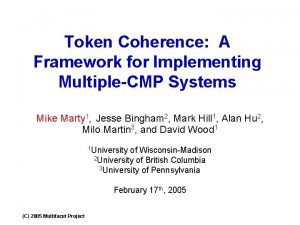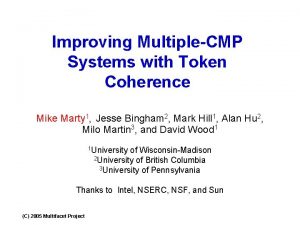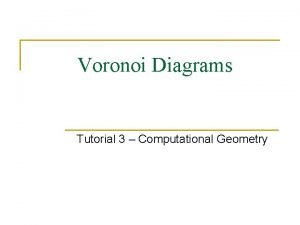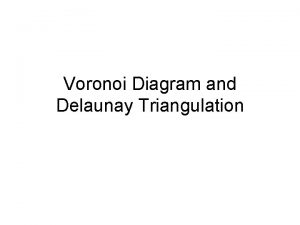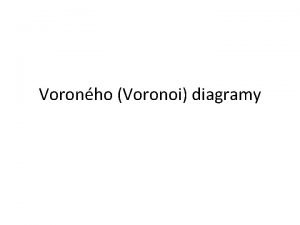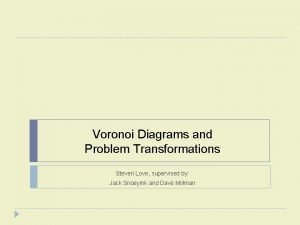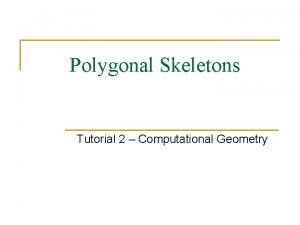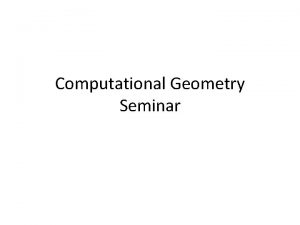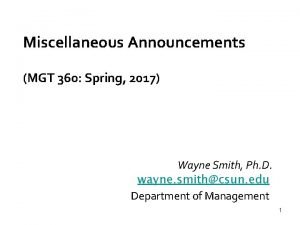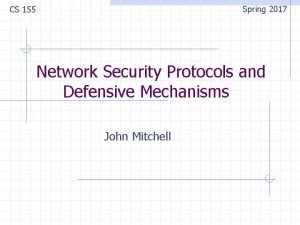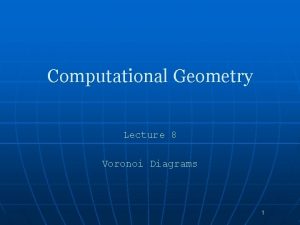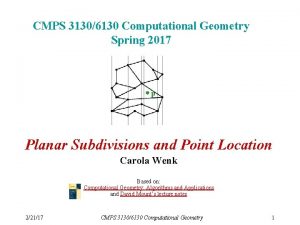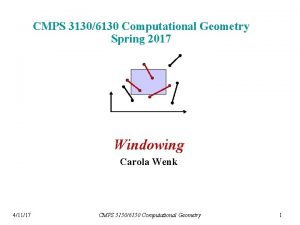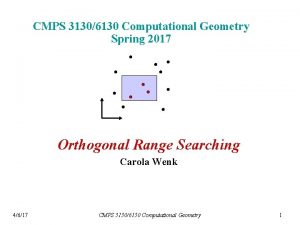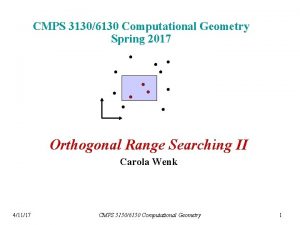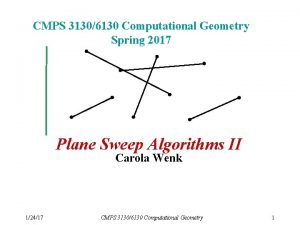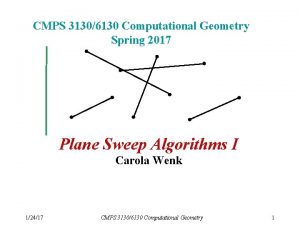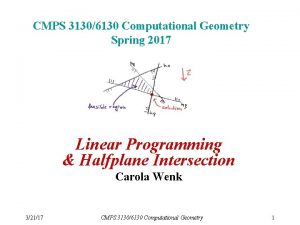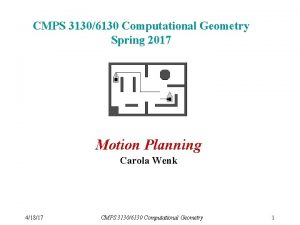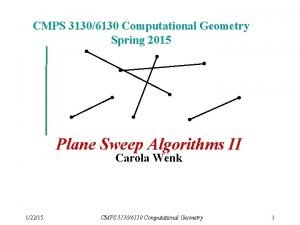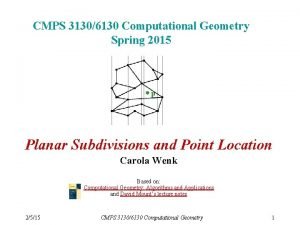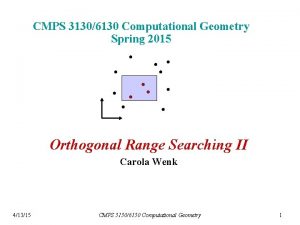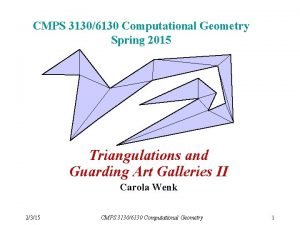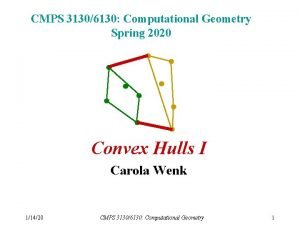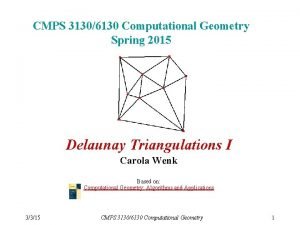CMPS 31306130 Computational Geometry Spring 2017 Voronoi Diagrams



















- Slides: 19

CMPS 3130/6130 Computational Geometry Spring 2017 Voronoi Diagrams Carola Wenk Based on: Computational Geometry: Algorithms and Applications 3/2/17 CMPS 3130/6130 Computational Geometry 1

Voronoi Diagram (Dirichlet Tesselation) • 3/2/17 CMPS 3130/6130 Computational Geometry 2

Applications of Voronoi Diagrams 3/2/17 CMPS 3130/6130 Computational Geometry 3

Bisectors r q p s q p 3/2/17 CMPS 3130/6130 Computational Geometry 4

Voronoi cell pj pi 3/2/17 CMPS 3130/6130 Computational Geometry 5

Voronoi Diagram Add vertex at infinity 3/2/17 CMPS 3130/6130 Computational Geometry 6

Properties Site with bounded Voronoi cell Site with unbounded Voronoi cell Smaller empty disk centered on Voronoi edge 3/2/17 Larger empty disk centered on Voronoi vertex CMPS 3130/6130 Computational Geometry 7

Fortune’s sweep to construct the VD Problem: We cannot maintain the intersection of the VD with sweepline l since the VD above l depends on the sites below l. Sweep line status: “Beach line” • Identify points q l+ for which we know their closest site. • If there is a site pi l+ s. t. dist(q, pi)≤dist(q, l) then the site closest to q lies above l. • Define the “beach line” as the boundary of the set of points q l+ that are closer to a site above l than to l. ® The beach line is a sequence of parabolic arcs ® The breakpoints (beach line vertices) lie on edges of the VD, such that they trace out the VD as the sweep line moves. 3/2/17 CMPS 3130/6130 Computational Geometry 8

Parabola Set of points (x, y) such that dist((x, y), p) = dist(l) for a fixed site p = (px, py) 3/2/17 CMPS 3130/6130 Computational Geometry 9

Site Events Site event: The sweep line l reaches a new site A new arc appears on the beach line… … which traces out a new VD edge 3/2/17 CMPS 3130/6130 Computational Geometry 10

Site Events Lemma: The only way in which a new arc can appear on the beach line is through a site event. Proof: • Case 1: Assume the existing parabola bj (defined by site pj) breaks through bi bi Formula for parabola bj : Using pjy>ly and piy>ly one can show that is impossible that bi and bj have only one intersection point. Contradiction. 3/2/17 CMPS 3130/6130 Computational Geometry 11

Site Events • Case 2: Assume bj appears on the break point q between bi and bk bi bk There is a circle C that passes through pi, pj, pk and is tangent to l: But for an infinitesimally small motion of l, either pi or pk penetrates the interior of C. Therefore bj cannot appear on l. 3/2/17 CMPS 3130/6130 Computational Geometry 12

Circle Events Circle event: Arc a’ shrinks to a point q, and then arc a’ disappears There is a circle C that passes through pi, pj, pk and touches l (from above). There is no site in the interior of C. (Otherwise this site would be closer to q than q is to l, and q would not be on the beach line. ) q is a Voronoi vertex (two edges of the VD meet in q). Note: The only way an arc can disappear from the beach line is through a circle event. 3/2/17 CMPS 3130/6130 Computational Geometry 13

Data Structures • Store the VD under construction in a DCEL • Sweep line status (sweep line): • Use a balanced binary search tree T, in which the leaves correspond to the arcs on the beach line. • Each leaf stores the site defining the arc (it only stores the site and not the arc) • Each internal node corresponds to a break point on the beach line • Event queue: • Priority queue Q (ordered by y-coordinate) • Store each point site as a site event. • Circle event: • Store the lowest point of a circle as an event point • Store a point to the leaf/arc in the tree that will disappear 3/2/17 CMPS 3130/6130 Computational Geometry 14

How to Detect Circle Events? Make sure that for any three consecutive arcs on the beach line the potential circle event they define is stored in the queue. Consecutive triples with breakpoints that do not converge do not yield a circle event. Note that a triple could disappear (e. g. , due to the appearance of a new site) before the event takes place. This yields a false alarm. 3/2/17 CMPS 3130/6130 Computational Geometry 15

Sweep Code 3/2/17 CMPS 3130/6130 Computational Geometry 16

Sweep Code • Degeneracies: • If two points have the same y-coordinate, handle them in any order. • If there are more than three sites on one circle, there are several coincident circle events that can be handled in any order. The algorithm produces several degree-3 vertices at the same location. • Theorem: Fortune’s sweep runs in O(n log n) time and O(n) space. 3/2/17 CMPS 3130/6130 Computational Geometry 17

Handling a Site Event Runs in O(log n) time per event, and there are n events. 3/2/17 CMPS 3130/6130 Computational Geometry 18

Handling a Circle Event Runs in O(log n) time per event, and there are O(n) events because each event defines a Voronoi vertex. False alarms are deleted before they are processed. 3/2/17 CMPS 3130/6130 Computational Geometry 19
 Cmps token
Cmps token Cmps token
Cmps token Voronoi diagram tutorial
Voronoi diagram tutorial Voronoi diagram
Voronoi diagram Diagram voronoi
Diagram voronoi Toxic waste dump problem voronoi
Toxic waste dump problem voronoi Matematika mindenkinek
Matematika mindenkinek Computational geometry tutorial
Computational geometry tutorial Computational geometry
Computational geometry Rake symbol in activity diagram
Rake symbol in activity diagram Use case model
Use case model Wayne smith csun
Wayne smith csun Ftp server spring 2017
Ftp server spring 2017 What months are spring summer autumn and winter
What months are spring summer autumn and winter Cast of spring, summer, fall, winter... and spring
Cast of spring, summer, fall, winter... and spring Fcat reference sheet
Fcat reference sheet Lewis dot structure and molecular geometry
Lewis dot structure and molecular geometry 4 electron domains 2 lone pairs
4 electron domains 2 lone pairs The basis of the vsepr model of molecular bonding is _____.
The basis of the vsepr model of molecular bonding is _____. Slo computational thinking
Slo computational thinking
